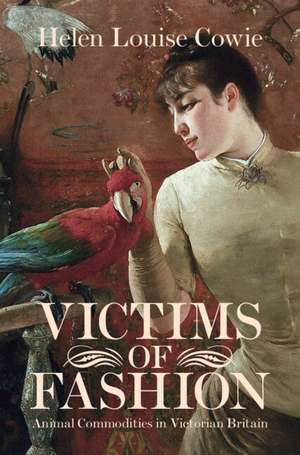Victims of Fashion: Science in History
Autor Helen Louise Cowieen Limba Engleză Hardback – 17 noi 2021
Din seria Science in History
-
 Preț: 308.39 lei
Preț: 308.39 lei -
 Preț: 406.55 lei
Preț: 406.55 lei -
 Preț: 283.25 lei
Preț: 283.25 lei -
 Preț: 189.99 lei
Preț: 189.99 lei -
 Preț: 306.86 lei
Preț: 306.86 lei -
 Preț: 306.30 lei
Preț: 306.30 lei -
 Preț: 324.96 lei
Preț: 324.96 lei -
 Preț: 324.24 lei
Preț: 324.24 lei -
 Preț: 224.62 lei
Preț: 224.62 lei -
 Preț: 243.15 lei
Preț: 243.15 lei -
 Preț: 288.42 lei
Preț: 288.42 lei -
 Preț: 221.56 lei
Preț: 221.56 lei -
 Preț: 206.39 lei
Preț: 206.39 lei -
 Preț: 230.49 lei
Preț: 230.49 lei - 11%
 Preț: 584.57 lei
Preț: 584.57 lei - 11%
 Preț: 585.10 lei
Preț: 585.10 lei - 14%
 Preț: 728.56 lei
Preț: 728.56 lei - 9%
 Preț: 593.41 lei
Preț: 593.41 lei - 11%
 Preț: 642.35 lei
Preț: 642.35 lei - 9%
 Preț: 592.87 lei
Preț: 592.87 lei
Preț: 274.69 lei
Nou
Puncte Express: 412
Preț estimativ în valută:
52.57€ • 54.68$ • 43.40£
52.57€ • 54.68$ • 43.40£
Carte disponibilă
Livrare economică 24 martie-07 aprilie
Livrare express 08-14 martie pentru 36.16 lei
Preluare comenzi: 021 569.72.76
Specificații
ISBN-13: 9781108495172
ISBN-10: 1108495176
Pagini: 300
Dimensiuni: 157 x 235 x 20 mm
Greutate: 0.54 kg
Ediția:Nouă
Editura: Cambridge University Press
Colecția Cambridge University Press
Seria Science in History
Locul publicării:Cambridge, United Kingdom
ISBN-10: 1108495176
Pagini: 300
Dimensiuni: 157 x 235 x 20 mm
Greutate: 0.54 kg
Ediția:Nouă
Editura: Cambridge University Press
Colecția Cambridge University Press
Seria Science in History
Locul publicării:Cambridge, United Kingdom
Cuprins
Introduction; 1. Murderous millinery; 2. The seal and his jacket; 3. Is the elephant following the dodo?; 4. Silk of the Andes; 5. Bitter perfumes; 6. Monkey business; Conclusion; Epilogue.
Recenzii
'From civets horribly confined to produce perfume scent to elephants killed for ivory billiard balls and piano keys, Cowie demonstrates how fashion “valued” animals, even while letters to the RSPCA illustrated concern for animal agency and welfare. Contemporary debates surrounding nonhuman animals' victimization are rooted in the human animal's propensity to display.' Abel Alves, Ball State University
'This remarkably powerful and elegantly crafted book explores the appeal of animal-based products in Victorian and Edwardian Britain. Taking us deep into the world of trading and consuming bird feathers, seal skins, ivory, and exotic pets, Victims of Fashion brims with historical insight about the consumption of these goods, but also, importantly, their decline in popularity.' Neil Pemberton, University of Manchester
'This is a fascinating book from start to finish, written with great verve and clarity. From animal acclimatisation schemes to exotic pet keeping, and from campaigns against animal cruelty and 'murderous millinery' to the beginnings of international wildlife conservation action, or the hunt to find synthetic substitutes for animal products, it sets some of the key questions of our time in a vivid historical context.' Sally Shuttleworth, University of Oxford
'This terrific book exposes how far elites were implicated in systemised animal cruelty (historically associated with the working classes) and illustrates that while women often were pioneering advocates of animal rights, they also constituted core markets for animal commodities.' Julie-Marie Strange, Durham University
'This remarkably powerful and elegantly crafted book explores the appeal of animal-based products in Victorian and Edwardian Britain. Taking us deep into the world of trading and consuming bird feathers, seal skins, ivory, and exotic pets, Victims of Fashion brims with historical insight about the consumption of these goods, but also, importantly, their decline in popularity.' Neil Pemberton, University of Manchester
'This is a fascinating book from start to finish, written with great verve and clarity. From animal acclimatisation schemes to exotic pet keeping, and from campaigns against animal cruelty and 'murderous millinery' to the beginnings of international wildlife conservation action, or the hunt to find synthetic substitutes for animal products, it sets some of the key questions of our time in a vivid historical context.' Sally Shuttleworth, University of Oxford
'This terrific book exposes how far elites were implicated in systemised animal cruelty (historically associated with the working classes) and illustrates that while women often were pioneering advocates of animal rights, they also constituted core markets for animal commodities.' Julie-Marie Strange, Durham University
Notă biografică
Descriere
Examines the extensive use of animal commodities in Victorian Britain and the humanitarian and ecological issues raised by their consumption.
